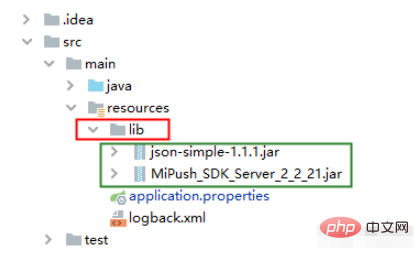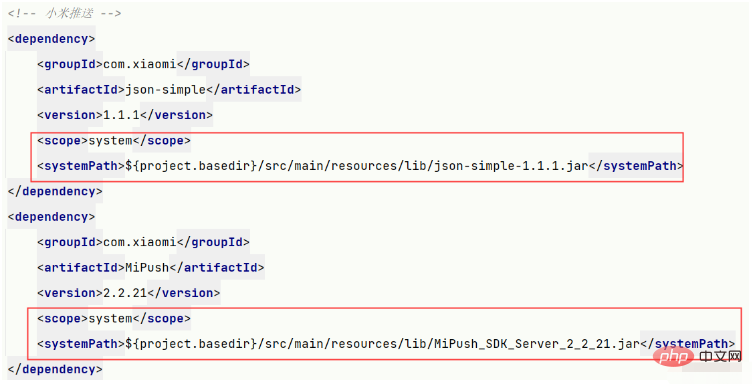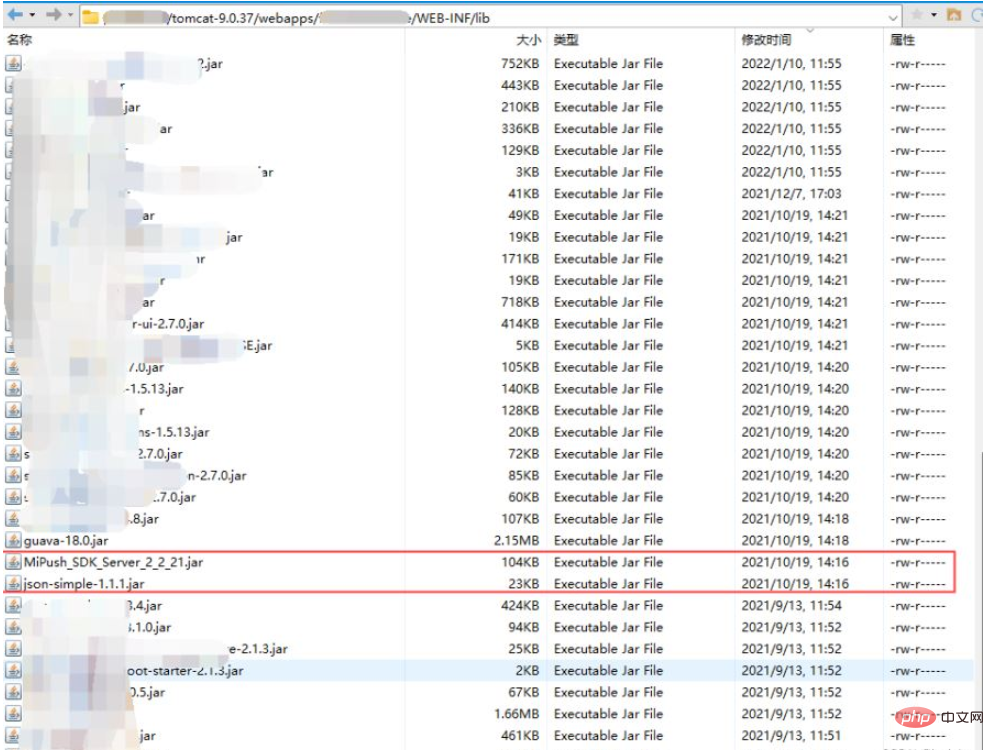 Java
Java
 javaTutorial
javaTutorial
 How to introduce local dependency jar package into springboot project and package it into lib folder
How to introduce local dependency jar package into springboot project and package it into lib folder
How to introduce local dependency jar package into springboot project and package it into lib folder
Foreword:
At work, I encountered a java web project built with the springboot framework that needed to integrate third-party push functions, so I used the Xiaomi push service and downloaded the relevant jar package. Introducing local jars into the project is not a big problem. After writing the code, it is no problem to pass the test class test. Then prepare to package and deploy to the development server. Since the project is deployed through tomcat, the packaging method is into a war package. After packaging, upload it to the development server. After successful startup, I went to test the written push interface and found that it failed.
Through analysis, we found that there are no push-related jar packages introduced locally in the lib directory where the project-dependent jars are stored in the packaged war. After struggling for half an hour, the problem was solved. After solving it, I discovered that I had actually forgotten the basic knowledge of maven. Here is a summary of how the springboot project introduces local jar packages and how to package the jars into the lib folder through maven packaging:
1. First create a lib folder in the resources directory and put the required jar packages into lib Folder

#2. In the pom.xml file, add dependent coordinates.
Note: Since the local jar is imported here,
<dependency> ... <!-- 表示当前jar是外部引入的,maven不会在repository查找它 --> <scope>system</scope> <!-- 指定引入的外部jar存放的路径,一般将jar包放在项目的某个目录下,通过相对路径指定 --> <systemPath>...</systemPath> </dependency>

<build>
<finalName>xxxxxx</finalName>
<plugins>
<!--配置将第三方jar打进jar包中,跟<packaging>jar</packaging>配合,如果不写,springboot默认是打成jar包-->
<!--<plugin>
<groupId>org.springframework.boot</groupId>
<artifactId>spring-boot-maven-plugin</artifactId>
<configuration>
<!-- 项目中单独引入第三方jar时,includeSystemScope值要为true
<includeSystemScope>true</includeSystemScope>
</configuration>
</plugin>-->
<!-- 打war包 -->
<plugin>
<groupId>org.apache.maven.plugins</groupId>
<artifactId>maven-war-plugin</artifactId>
<version>3.2.2</version>
<configuration>
<webResources>
<!-- 配置将第三方jar打进war包中,跟<packaging>war</packaging>配合 -->
<webResource>
<directory>${pom.basedir}/src/main/resources/lib/</directory>
<targetPath>WEB-INF/lib/</targetPath>
<includes>
<include>**/*.jar</include>
</includes>
</webResource>
</webResources>
</configuration>
</plugin>
</plugins>
</build>Copy after login According to the needs of the project, it is deployed as a jar package or a war package. Different plug-ins need to be introduced and added Different configurations. If you need to package it into a war package, don't forget to add the war configuration in the pom.xml file.
4. Test and verify after packaging and deploymentYou can test by calling the relevant interface, or you can directly observe whether the imported local jar exists in the lib folder in the deployment package to determine
<build>
<finalName>xxxxxx</finalName>
<plugins>
<!--配置将第三方jar打进jar包中,跟<packaging>jar</packaging>配合,如果不写,springboot默认是打成jar包-->
<!--<plugin>
<groupId>org.springframework.boot</groupId>
<artifactId>spring-boot-maven-plugin</artifactId>
<configuration>
<!-- 项目中单独引入第三方jar时,includeSystemScope值要为true
<includeSystemScope>true</includeSystemScope>
</configuration>
</plugin>-->
<!-- 打war包 -->
<plugin>
<groupId>org.apache.maven.plugins</groupId>
<artifactId>maven-war-plugin</artifactId>
<version>3.2.2</version>
<configuration>
<webResources>
<!-- 配置将第三方jar打进war包中,跟<packaging>war</packaging>配合 -->
<webResource>
<directory>${pom.basedir}/src/main/resources/lib/</directory>
<targetPath>WEB-INF/lib/</targetPath>
<includes>
<include>**/*.jar</include>
</includes>
</webResource>
</webResources>
</configuration>
</plugin>
</plugins>
</build>
The above is the detailed content of How to introduce local dependency jar package into springboot project and package it into lib folder. For more information, please follow other related articles on the PHP Chinese website!

Hot AI Tools

Undresser.AI Undress
AI-powered app for creating realistic nude photos

AI Clothes Remover
Online AI tool for removing clothes from photos.

Undress AI Tool
Undress images for free

Clothoff.io
AI clothes remover

AI Hentai Generator
Generate AI Hentai for free.

Hot Article

Hot Tools

Notepad++7.3.1
Easy-to-use and free code editor

SublimeText3 Chinese version
Chinese version, very easy to use

Zend Studio 13.0.1
Powerful PHP integrated development environment

Dreamweaver CS6
Visual web development tools

SublimeText3 Mac version
God-level code editing software (SublimeText3)

Hot Topics
 How Springboot integrates Jasypt to implement configuration file encryption
Jun 01, 2023 am 08:55 AM
How Springboot integrates Jasypt to implement configuration file encryption
Jun 01, 2023 am 08:55 AM
Introduction to Jasypt Jasypt is a java library that allows a developer to add basic encryption functionality to his/her project with minimal effort and does not require a deep understanding of how encryption works. High security for one-way and two-way encryption. , standards-based encryption technology. Encrypt passwords, text, numbers, binaries... Suitable for integration into Spring-based applications, open API, for use with any JCE provider... Add the following dependency: com.github.ulisesbocchiojasypt-spring-boot-starter2. 1.1Jasypt benefits protect our system security. Even if the code is leaked, the data source can be guaranteed.
 How to run jar files in Linux
Feb 20, 2024 am 10:40 AM
How to run jar files in Linux
Feb 20, 2024 am 10:40 AM
Prerequisites for running JAR files Running JAR files on a Linux system requires the installation of the Java Runtime Environment (JRE), which is the basic component required to execute Java applications, including the Java Virtual Machine (JVM), core class libraries, etc. Many mainstream Linux distributions, such as Ubuntu, Debian, Fedora, openSUSE, etc., provide software libraries of JRE packages to facilitate user installation. The following article will detail the steps to install JRE on popular distributions. After setting up the JRE, you can choose to use the command line terminal or the graphical user interface to start the JAR file according to your personal preference. Your choice may depend on familiarity with Linux shells and personal preference
 How to use Redis to implement distributed locks in SpringBoot
Jun 03, 2023 am 08:16 AM
How to use Redis to implement distributed locks in SpringBoot
Jun 03, 2023 am 08:16 AM
1. Redis implements distributed lock principle and why distributed locks are needed. Before talking about distributed locks, it is necessary to explain why distributed locks are needed. The opposite of distributed locks is stand-alone locks. When we write multi-threaded programs, we avoid data problems caused by operating a shared variable at the same time. We usually use a lock to mutually exclude the shared variables to ensure the correctness of the shared variables. Its scope of use is in the same process. If there are multiple processes that need to operate a shared resource at the same time, how can they be mutually exclusive? Today's business applications are usually microservice architecture, which also means that one application will deploy multiple processes. If multiple processes need to modify the same row of records in MySQL, in order to avoid dirty data caused by out-of-order operations, distribution needs to be introduced at this time. The style is locked. Want to achieve points
 How SpringBoot integrates Redisson to implement delay queue
May 30, 2023 pm 02:40 PM
How SpringBoot integrates Redisson to implement delay queue
May 30, 2023 pm 02:40 PM
Usage scenario 1. The order was placed successfully but the payment was not made within 30 minutes. The payment timed out and the order was automatically canceled. 2. The order was signed and no evaluation was conducted for 7 days after signing. If the order times out and is not evaluated, the system defaults to a positive rating. 3. The order is placed successfully. If the merchant does not receive the order for 5 minutes, the order is cancelled. 4. The delivery times out, and push SMS reminder... For scenarios with long delays and low real-time performance, we can Use task scheduling to perform regular polling processing. For example: xxl-job Today we will pick
 How to solve the problem that springboot cannot access the file after reading it into a jar package
Jun 03, 2023 pm 04:38 PM
How to solve the problem that springboot cannot access the file after reading it into a jar package
Jun 03, 2023 pm 04:38 PM
Springboot reads the file, but cannot access the latest development after packaging it into a jar package. There is a situation where springboot cannot read the file after packaging it into a jar package. The reason is that after packaging, the virtual path of the file is invalid and can only be accessed through the stream. Read. The file is under resources publicvoidtest(){Listnames=newArrayList();InputStreamReaderread=null;try{ClassPathResourceresource=newClassPathResource("name.txt");Input
 Comparison and difference analysis between SpringBoot and SpringMVC
Dec 29, 2023 am 11:02 AM
Comparison and difference analysis between SpringBoot and SpringMVC
Dec 29, 2023 am 11:02 AM
SpringBoot and SpringMVC are both commonly used frameworks in Java development, but there are some obvious differences between them. This article will explore the features and uses of these two frameworks and compare their differences. First, let's learn about SpringBoot. SpringBoot was developed by the Pivotal team to simplify the creation and deployment of applications based on the Spring framework. It provides a fast, lightweight way to build stand-alone, executable
 How SpringBoot customizes Redis to implement cache serialization
Jun 03, 2023 am 11:32 AM
How SpringBoot customizes Redis to implement cache serialization
Jun 03, 2023 am 11:32 AM
1. Customize RedisTemplate1.1, RedisAPI default serialization mechanism. The API-based Redis cache implementation uses the RedisTemplate template for data caching operations. Here, open the RedisTemplate class and view the source code information of the class. publicclassRedisTemplateextendsRedisAccessorimplementsRedisOperations, BeanClassLoaderAware{//Declare key, Various serialization methods of value, the initial value is empty @NullableprivateRedisSe
 How to implement Springboot+Mybatis-plus without using SQL statements to add multiple tables
Jun 02, 2023 am 11:07 AM
How to implement Springboot+Mybatis-plus without using SQL statements to add multiple tables
Jun 02, 2023 am 11:07 AM
When Springboot+Mybatis-plus does not use SQL statements to perform multi-table adding operations, the problems I encountered are decomposed by simulating thinking in the test environment: Create a BrandDTO object with parameters to simulate passing parameters to the background. We all know that it is extremely difficult to perform multi-table operations in Mybatis-plus. If you do not use tools such as Mybatis-plus-join, you can only configure the corresponding Mapper.xml file and configure The smelly and long ResultMap, and then write the corresponding sql statement. Although this method seems cumbersome, it is highly flexible and allows us to





